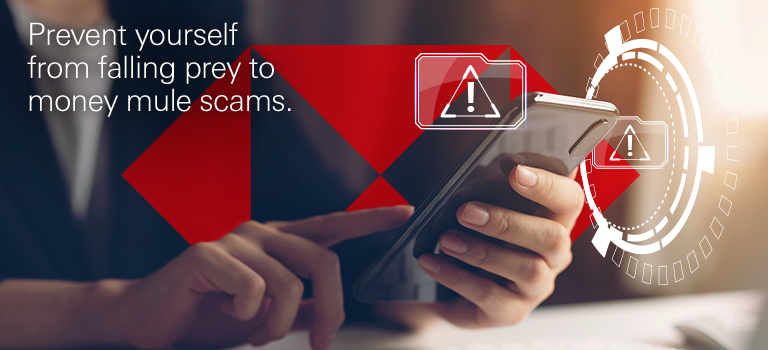
|

|
|
Dear Customer,
|
|
Deals that sound too good to be true are potentially a malicious tactic from scammers looking to turn you into a 'money mule'.
|
|
How do scammers from a mule scam syndicate lure in victims?
|
|
The scammers will contact you via email or use trustworthy-looking adverts on websites and social media to approach you with lucrative offers in exchange for your help in creating a bank account for them under your name. They also operate by paying you to have money transferred via your bank account.
|
|
A common target of these scammers are students low on funds. They will use job adverts and spam emails offering 'easy money'. The victim will be asked to provide their bank details so the scammers can transfer money into their account and then, the victim will be required to either withdraw it in cash or transfer it to another account. While this seems like a harmless way to earn some income, the transferred money is actually stolen and used to fund organised crime.
|
|
Don't fall for scams that offer a huge monetary reward in exchange for the use of your bank account. Accepting the deal can land you in a fraud case.
|

|
|
What can happen if you've accidentally fallen victim to a mule account scam?
|

|
Should your involvement be discovered, enforcement action may be taken against you.
|

|
Your bank accounts will be closed.
|

|
You may face difficulties in opening a new bank account.
|

|
You may not be able to get a loan in the future.
|
|

|
|

|
|
How can you protect yourself from financial loss?
|

|
Always ensure your bank account is secure.
|

|
Don't share or allow others access to your confidential bank details.
|

|
Don't use your bank account to help receive funds from and/or transfer funds to third parties.
|
|

|
|

|
|
What can you do if you suspect that you're a mule account scam victim?
|
|
If you think your bank account is being misused by the syndicate, visit the Semak Mule website to check. Then, contact and report to the authorities as soon as possible.
|

|
|

|
|
Beware of financial scams promising unrealistic high returns. If it sounds too good to be true, it probably is.
Do not be a scam victim. When in doubt, call
BNMTELELINK at 1-300-88-5465.
Want more security tips to safeguard your online banking activities?

|
|
|
Is there an unusual transaction in your statement?
Report it immediately
|
|
|
For further assistance or enquiries, reach out to us via:
Secure Live Chat
from 9am to 6pm, Monday to Friday except public holidays. Log onto HSBC Online Banking, or HSBC Malaysia Mobile Banking App via ‘Chat with us’ under the Support tab.
Call our Contact Centre
at the numbers below. Select “To report Lost/Stolen/Unauthorised transactions” to report a fraudulent transaction or if you think your account is compromised.
HSBC: 1300-88-1388 or (603) 8321 5400 (overseas)
HSBC Amanah: 1300-80-2626 or (603) 8321 5200 (overseas)
from 7:30am - 9:30pm
|
|
|
For more information or to check on police reports and investigation status, please reach out to CCIS Scam Response Centre

|
03-2610 1559 / 03-2610 1599
(from 8am to 8pm)
|
|
|
|
|

|
013-211 1222
(from 8am to 12 midnight)
|
|
These links exit an HSBC controlled environment. Please refer to our hyperlink policy at https://www.hsbc.com.my/hyperlink-policy/
|
|
|
|
Get your banking
done with a tap
HSBC Malaysia App lets you transact
on-the-go
with ease.
|
|
|
|
|

|
|
A reminder to all our customers
|
|
|
Don't become a victim of scams and phishing. Remember, the police, government or
other law enforcement agencies won't ever make phone calls to ask you to transfer
funds to unfamiliar third-party accounts on the pretext of investigations. HSBC will
never send any SMS notification with a link requesting you to log on to your
Internet banking. If you're ever unsure about a message you've received, please
contact Customer Services for advice. Never share your Internet Banking ID,
Password/PIN/OTP with anyone. You are encouraged to change your passwords and PIN
regularly.
|
|
|